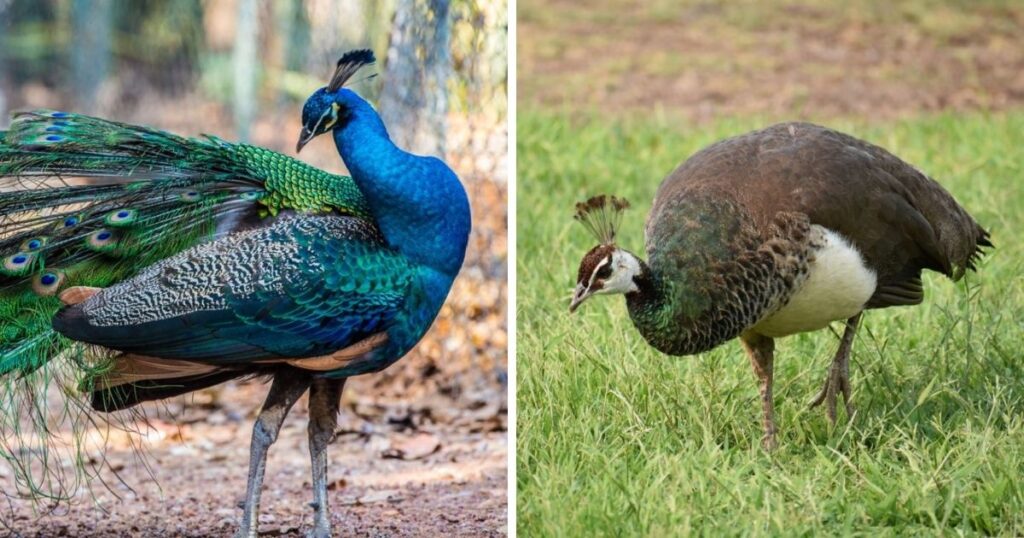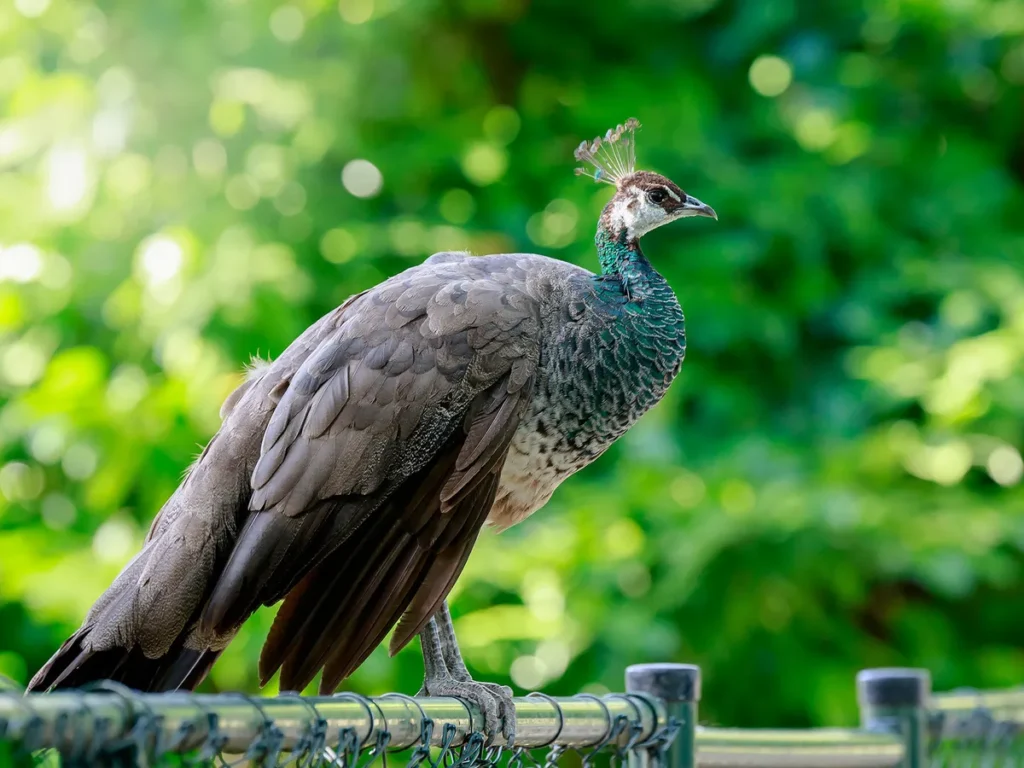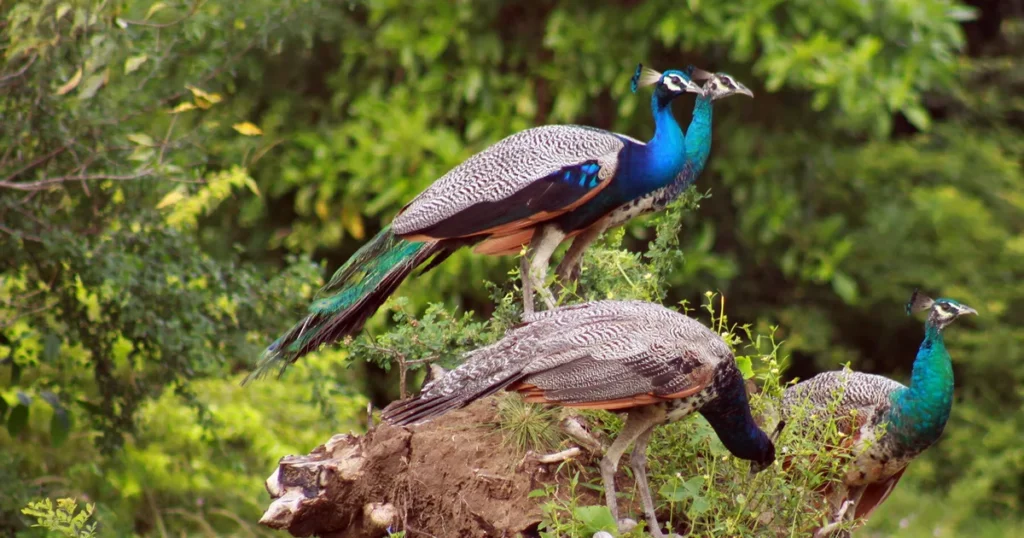Peacock vs Peafowl
It is for good reason that the phrases “Peacock” and “Peafowl” refer to the same kind of bird that is a member of the Phasianidae family.
However, the name “Peafowl” applies to both genders of the species, whereas “Peacock” refers to the male of the species. It is simple to determine which relates to the male bird even in the absence of this explanation.

Here is a more thorough description of the distinctions between a peacock and a peafowl in case you’re still unsure:
What is Peacock?
A peacock is the name for the male peafowl. These birds, which belong to the pheasant family, are primarily terrestrial and have colorful plumage.
The train, or fan-shaped tail feathers, of peacocks are adorned with bright eyespots known as ocelli and measure between 55 and 63 inches in length.
Peacocks are among the most magnificent birds in the world because of their complete plumage, which is a display of iridescent colors. It’s not only their train that’s magnificent.
Although they are nonetheless amazing, the females of the species are not nearly as remarkable as the males.
What is Peafowl?
Both the male and female of the species are referred to as “peafowls” in this context. Peafowl are divided into three species, each having unique characteristics and varied geographic ranges.
The Indian peafowl, also known as the blue peafowl, the Congo peafowl, also known as the African peafowl, and the Green peafowl, sometimes known as the Asian peafowl, are the three species of peafowl.
Of these, the Congo peafowl is classified as vulnerable on the IUCN Red List and the Green peafowl as endangered since 2009.
Most of the time, people merely refer to either gender of the species by using the phrase “peacock,” even though “peafowl” is the proper term to describe both.
However, the term for female peafowls is different. This lead us to the following point:
What Is the Name of a Female Peacock?
The female peafowl is referred to as a peahen, if the male is termed a peacock. Comparing peacocks to peahens, the latter are larger and more showy. By all means, though, peahens are still striking birds.

Naturally, because we’re talking about the females of the species, we should also talk about the newborn peafowl’s name. Peachicks are the young peafowls.
When you think about it, the female and young peafowl are referred to by the same names used to describe chickens—hen for the mother and chick for the youngster.
What Separates a Peahen from a Peacock?
As of now, we know that the peahen is the female peafowl and the peacock is the male. What distinguishes the two, though?

The following are some distinctions between peacocks and peahens:
Size
Peacocks are larger than peahens. To what extent is it smaller? To put it mildly, there is a discernible difference.
The female Green peafowl, for instance, is only about half the length of the breeding male, measuring between 1 and 1.1 meters (3 feet 3 inches to 3 feet 7 inches), compared to the male’s 1.8 to 3 meters (5 feet 11 inches to 9 feet 10 inches) in total length.
When contrasting the male and female Congo peafowl, there is not much of a size difference. The difference between the two is still about 3–4 inches.
Weight
The weight difference is another distinction. Peacocks weigh more because they are bigger than other animals.
The peahen weighs just 6-8.8 lbs (2.8 – 6 kg), but an Indian peacock, for example, weighs around 8.8–13 pounds (4-6 kg).
Train
The train that appears in the form of a fan in peacocks is absent from females of the species. During courting, peacocks shake them to entice or impress females.
It was long believed that the complex tail feathers arose because peahens preferred them, but more research has not shown any proof to back up these theories.
Color of Plumage
An other distinction between a peahen and a peacock is the hue of their feathers. The hues of feathers differ across different species.
With the exception of the Green peafowl, which has less noticeable variations in plumage color, the other two species of peafowl exhibit noticeable variations in plumage color.

For instance, the head, neck, and breasts of the Blue Peacock are covered with shimmering blue plumage. Bronze green, the base and rear of the tail feathers resemble scales. Olive green eyespots adorn the train’s exterior.
The species’ peahen, on the other hand, has a rufous-brown head and a brownish upper body with little mottling.
It’s also clear that the male and female Congo peafowls have different plumage. The Congo peacock’s upperpants are colored blue and have brownish-green feathers. The head, underwear, and neck are all rather black. There’s a red area of skin on the neck.
The Congo peahen’s upperpants are mossy-green, while its underpants are rusty brown.
Consequently, you can always depend on the color of the plumage to distinguish between a peacock and a peahen if size turns out to be a poor predictor.
What Is the Name of a Group of Peafowl?
After defining a peafowl, peacock, and peahen, let’s examine which term is used to refer to a bunch of peafowl.
A group of peafowl is actually referred to by three terms: a “Ostentation,” a “Muster,” or a “Pride.”
Among them, “Ostentation” would be the most appropriate term to describe a flock of peafowls. The name means “a pretentious or showy display,” which, to be honest, describes these birds rather well.

Summary
While the phrases peacock and peafowl are synonymous, peacock refers only to the male peafowl, whilst peafowl also refers to the female bird. Peahens are the female form of peafowl.
In addition to defining these terms, I’ve also discussed the characteristics that distinguish a peahen from a peacock, such as size, weight, color of plumage, train, etc.
Even with these distinctions, you could still be unable to tell a peahen from a peacock unless they are side by side, in which case you can tell which is which just by comparing their sizes and colors.
